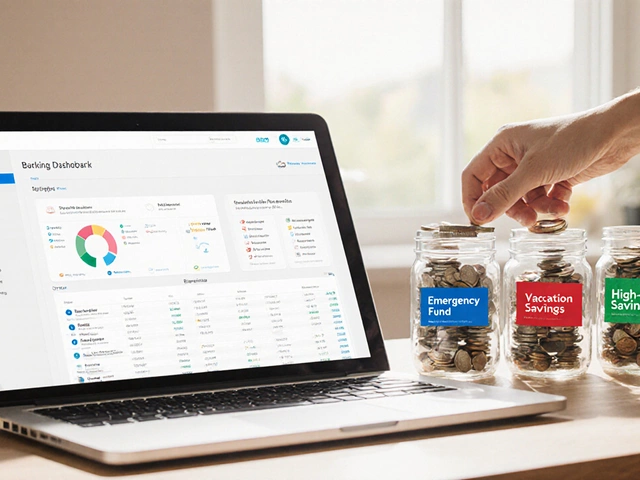
Inflation is like a silent pickpocket; it steals the value of your money without you even realizing it. For those in India trying to preserve and grow their wealth, learning effective ways to counter inflation is crucial. This issue has never been more urgent as fluctuating prices impact household budgets and future financial planning.
This article is here to offer guidance through a myriad of investment strategies that can help you maintain your financial footing amid the storm of inflation. We'll delve into traditional investments, the stabilizing potential of precious metals and real estate, and anticipate emerging trends in the Indian financial landscape. Together, these strategies will not only help you keep up with inflation but might also give your portfolio the boost it has been looking for.
- Understanding Inflation in India
- Traditional Investment Options
- Investing in Precious Metals
- Real Estate as a Hedge Against Inflation
- Emerging Trends and Future Insights
Understanding Inflation in India
Inflation in India can be likened to that tricky magician who appears from nowhere and seems to touch every aspect of your daily life. It's the rate at which the general level of prices for goods and services is rising, and subsequently, purchasing power is falling. A family that was once able to fill their grocery cart with a certain sum may now find the same sum buys fewer items. In India, this situation is especially noticeable given the diverse economic spectrum represented in the country, where both high-growth urban areas coexist with rural economies heavily dependent on traditional agriculture.
The investment plans available must consider the complex causes of inflation in India's market, including demand-pull effects, cost-push factors, and structural challenges. For instance, the country's heavy reliance on imports for crude oil means that any global hike in oil prices translates to increased transportation costs, affecting prices of basic commodities. Historical data shows that from 2012 to 2014, India faced significant inflation pressures with rates peaking over 10%. This situation prompted the Reserve Bank of India (RBI) to take stringent measures, such as increasing interest rates, to curb inflation.
According to Raghuram Rajan, the former governor of RBI, "Inflation kills the savings of the common man and especially of the retired people."
India's demographic dividend, with a large working-age population, should theoretically mean more production and less inflation. However, high inflation can negate buying power, creating a phenomenon where consumers feel poorer even if their incomes rise. The Consumer Price Index (CPI) often serves as a key indicator of inflation, reflecting price changes from the consumer's perspective; the inflation rate based on CPI was reported to have surpassed 6% on multiple occasions over the past decade.
But fighting inflation isn't merely a job for policymakers. Individuals can take steps too. Recognizing its impact, people might opt for investments in equities, which historically provide higher returns over the long term. For many, examining the diversified structure of India's GDP can also provide insights into which sectors might offer protection against inflation. Agriculture, for instance, is often hit hardest, whereas technology and renewable sectors might provide more stable prospects.
Given its multifaceted nature, understanding inflation in India fuses the local and the global. With a growing tech sector and advancements in renewable energy, India's economic landscape presents both challenges and opportunities. Tackling inflation becomes easier when one has a firm grasp of not just its present impact but its historical footprints. This wisdom then aids in crafting financial strategies to weather the ubiquitous economic fluctuation that inflation brings.
Traditional Investment Options
When it comes to plotting a course through the turbulent waters of inflation, many investors in India still place their trust in traditional investment options. These methods have stood the test of time, offering a combination of relative safety and steady returns. Let's explore some of these reliable pathways.
Bonds, particularly government securities, are a go-to choice for conservative investors. Known as a secure investment, bonds provide a fixed income that can help offset inflation to an extent. The Reserve Bank of India often issues Government Securities (G-Secs) to finance the fiscal deficit, presenting a low-risk investment opportunity. However, their returns might not always match up with the rate of inflation. For those who are risk-averse, they offer peace of mind with their capital protection features.
Another cornerstone of traditional investment is recurring deposits (RD) and fixed deposits (FD). Offered by almost every bank in India, these instruments are simple to understand and manage. Fixed deposits, in particular, provide a fixed return over a specified tenure, making them a favored option. However, it's vital to note that while FDs have been a staple of financial planning, the interest rates currently hover around or slightly above the inflation rate. As of the latest data from 2023, major banks offer FD rates averaging between 5% to 7%, which can sometimes just about fend off inflation bites.
Stock Market Investments and Mutual Funds
Stocks and mutual funds also fall under the traditional investment category, albeit with a higher risk profile. Investing in stocks of companies likely to perform well irrespective of economic cycles can be rewarding. Historically, equity has delivered returns that have outpaced inflation. According to SEBI, the average long-term return from equity blended funds has been around 12%, making it a compelling choice for the adventurous at heart. However, the stock market requires careful scrutiny and ideally, the guidance of seasoned professionals."Investing isn’t about beating others at their game. It’s about controlling yourself at your own game." — Benjamin Graham
Mutual funds offer a basket of investments, carefully curated to suit different risk appetites and financial goals. Equity mutual funds are often recommended because they expose you to a diverse range of sectors. With options like equity-linked saving schemes (ELSS), investors also benefit from tax deductions under Section 80C, further enhancing their appeal.
Data Supporting Investment Choices
Here is a table describing the return rates of traditional investments, which seasoned investors might find insightful:| Investment Type | Average Return Rate (%) |
|---|---|
| Government Bonds | 5-6% |
| Fixed Deposits | 5-7% |
| Equity Mutual Funds | 12% |
Traditional investment options have a proven track record, yet they come with their own set of challenges, especially in outperforming inflation. Therefore, diversifying with some riskier, yet potentially more rewarding, options might form a balanced approach in your investment strategy. As always, it pays to stay informed and adapt your strategy in line with evolving financial landscapes.

Investing in Precious Metals
When it comes to protecting your wealth against the relentless bite of inflation, investing in precious metals has long been a favored strategy. Gold and silver have been viewed as stores of value for centuries, offering a sense of stability in times of economic turbulence. These metals do not only offer an edge against inflation but also provide a tangible asset that can appreciate over time. Historically, gold prices tend to increase as the purchasing power of currency declines, making it a natural hedge against inflationary pressures.
India, with its cultural affinity for gold, makes investing in this metal not just an economic action, but a culturally resonant one. According to the World Gold Council, Indian households collectively own over 25,000 tons of gold, making India one of the largest markets for gold globally. This love affair with gold serves as both a financial strategy and a tradition-bound practice. Investors should consider not only buying physical gold in forms such as jewelry and coins but also explore other options like Gold ETFs and sovereign gold bonds as part of a diversified investment strategy.
Yet, some might ask if investing in these shiny assets is worth it in a modern financial landscape replete with high-tech stocks and cryptocurrencies. While technology and digital currencies have risen in prominence, precious metals such as gold and silver possess intrinsic qualities immune to the influence of central banks and technologies. "Gold is money. Everything else is credit," said J.P. Morgan, emphasizing its enduring value. In times of economic distress, when digital markets may experience volatility, these metals often witness a rise in demand as investors seek out reliable alternatives.
Aside from gold, silver holds a unique appeal as well. It has industrial applications that gold does not, giving it double-edged demand. Its relatively lower market price also makes it an accessible choice for younger or first-time investors diving into the realm of precious metals. An investment in silver is not only a hedge against inflation but also a stake in the growth of industries like electronics and renewable energy that utilize silver, potentially driving up its future demand.
To truly navigate this investment landscape effectively, individuals should remain informed about market conditions affecting precious metal prices. It is equally essential to decide whether to go all in on physical ownership or to diversify through financial instruments representing metal ownership. Analysts recommend keeping a portion of one's portfolio—typically 5%-10%—in precious metals to balance risk while potentially reaping rewards. By effectively involving these metals in a comprehensive financial strategy, you guard against inflation while inviting the possibility of significant profit, particularly when global markets experience turbulent shifts.
Real Estate as a Hedge Against Inflation
The allure of real estate as a bulwark against inflation has been well documented across various economic cycles. When we talk about the power of real estate in the Indian context, we are referring to a market that offers more than just financial returns. It provides stability, security, and a tangible asset that stands tall amidst financial storms. One of the intriguing aspects of real estate is its capability to yield steady rental income which generally rises with inflation. This nature of income, coupled with potential property value appreciation, makes real estate an attractive option for those looking to shield their assets from the erosion of value that inflation can bring. Moreover, real estate investments come with certain tax benefits in India which can further tip the scales in its favor.
The process of purchasing property in India, whether it's residential or commercial, needs careful examination of location, market trends, and future development plans. Urban areas with expanding infrastructure projects are often seen as hotbeds for property investment, offering promising returns. Take cities like Bangalore and Hyderabad; these cities have witnessed exponential growth in real estate value due to IT booms and urban migration. Investing in India offers the advantage of being part of a growing economy, where demand for residential and commercial spaces continues to soar. Investors should focus on regions with rising economic activity and job opportunities to ensure the value of their investment persists against inflation.
Another factor to consider is that real estate assets are not as liquid as other investments. This necessitates a long-term view, combined with a thorough assessment of financial capability and objectives. Despite this drawback, many experts hold an optimistic view. As noted by real estate expert Anuj Puri, "Real estate has historically proven to be a durable performer during inflation periods, fundamentally because both rental income and capital values tend to move with inflation." This perspective offers reassurance to those wary of the volatile nature of markets, painting real estate as a reliable pillar.
For an emerging investor in India, an exploration into real estate investment trusts (REITs) can be enlightening. These instruments offer exposure to real estate without the need to buy and manage properties directly. REITs are traded like stocks and provide dividends like rental income, with the added benefit of liquidity. The Indian government introduced REITs only a few years ago, but their presence has brought significant investment into the sector, offering heightened security and growth prospects.
India's real estate sector is vast, and it's important to diversify within this asset class. By investing in both residential and commercial properties, one can potentially balance risks and rewards. The commercial sector, in particular, has been gaining traction with the rise of business parks and coworking spaces. Data shows consistent demand for office spaces in tech-centric cities which can make commercial real estate a lucrative part of the strategy against inflation.

Emerging Trends and Future Insights
In the realm of investment, staying ahead of the curve can spell the difference between mere survival and significant financial growth. As India undergoes rapid economic transitions, new investment trends are emerging that promise to offer substantial opportunities for those willing to embrace them. A key trend shaping the future of investing in India is the rise of cryptocurrency as a legitimate investment class. While this digital asset class remains volatile, its potential for high returns cannot be ignored, offering an alternative way to outpace inflation. Indian investors, especially tech-savvy millennials, are increasingly viewing cryptocurrencies like Bitcoin and Ethereum as attractive options. Market studies suggest a growing acceptance and regulatory clarity could push these digital assets into more mainstream investment portfolios, serving as a dynamic edge against inflation.
Another emerging avenue is the surge in sustainable and socially responsible investing, commonly known as SRI. As awareness about environmental, social, and governance (ESG) issues reaches a crescendo, more investors want their money to reflect their values. Companies that score high on ESG parameters often demonstrate resilience during economic downturns, a crucial factor in inflationary periods. In this landscape, reliance on traditional investment vehicles is becoming less predominant. Consider a shift toward green energy and clean-tech stocks, both poised for growth due to increasing regulatory support and changing consumer preferences. This pivot is not just a trend but perhaps a necessity, as themes around climate change continue to garner investor focus globally.
Furthermore, technology-driven investments are becoming pronounced with innovations in artificial intelligence and machine learning taking the lead. These sectors offer explosive growth potential, and investing in them could be an effective strategy to counter inflation's eroding impact. Digital platforms and fintech ecosystems present an undeniable shift towards more efficient, user-centric investing methods. Investors can harness AI-powered analytical tools to glean new insights into market trends, optimizing their portfolios to maximize returns. Companies at the vanguard of AI innovation often fetch premium valuations, allowing early investors to thrive.
Another promising trend is the impact of demographic changes on real estate investments. As urban areas swell, driven by a burgeoning middle class, real estate remains a prime hedge against inflation. Areas experiencing significant urbanization often benefit from infrastructure improvements and a continual rise in demand for dwelling spaces, ensuring their appeal as a prong in the fight against inflation. Investing in commercial properties, especially in tier-2 and tier-3 cities, might yield remarkable returns as new business centers emerge.
The FinTech revolution is transforming the landscape, enabling access to a gamut of unique financial products that cater to a diverse array of investor profiles. Companies offering platforms for peer-to-peer lending, robo-advising, and micro-investing are creating tailwinds in the market, emerging as alternative channels for wealth creation. The convenience, inclusivity, and customized approaches these platforms offer are particularly appealing to younger generations, making them an attractive option amidst inflationary pressures.
The Financial Express recently reported, "India's rise as a 'FinTech Hub' is not merely a trend but a signpost to a new financial ecosystem emerging across Asia."
An investor's journey in the Indian market is punctuated by evolving aspirations and challenges, with inflation persistently testing even the most robust strategies. However, engaging with emerging trends and understanding future insights can empower investors to not only safeguard but potentially amplify their investments. Industry experts advocate that vigilant observation of market movements and nimble adaptation could well be the strategic playbook for harnessing these opportunities effectively.






Write a comment